Chapter 8: Non-current assets
Chapter learning objectives
Upon completion of this chapter you will be able to:
- define non-current assets
- distinguish between capital and revenue expenditure
- explain the function and purpose of an asset register
- explain and illustrate the ledger entries to record the acquisition of non-current assets
- define and explain the purpose of depreciation
- explain the straight-line and reducing balance methods of depreciation and make necessary calculations
- explain and illustrate how depreciation expense and accumulated depreciation are recorded in ledger accounts
- explain and illustrate how depreciation is presented in the income statement and statement of financial position
- explain the relevance of consistency and subjectivity in accounting for depreciation
- make the necessary adjustments if changes are made in the estimated useful life/residual value of a non-current asset
- explain and illustrate the ledger entries to record the disposal of non-current assets for cash
- explain and illustrate the ledger entries to record the disposal of non-current assets through part exchange
- explain and illustrate the inclusion of profits or losses on disposal in the income statement
- explain and record the revaluation of a non-current asset in ledger accounts and in the statement of financial position
- explain the impact of a revaluation on accounting for depreciation and disposal of a non-current asset
- explain and illustrate how non-current asset balances and movements are disclosed in company financial statements.
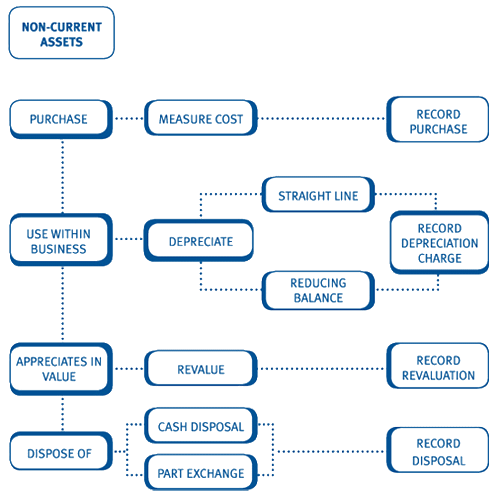
 1 Non-current assets
1 Non-current assets
Non-current assets are distinguished from current assets by the following characteristics: they:
- are long-term in nature
- are not normally acquired for resale
- are could be tangible or intangible
- are used to generate income directly or indirectly for a business
- are not normally liquid assets (i.e. not easily and quickly converted into cash without a significant loss in value).
2 Capital and revenue expenditure
It follows that a business' expenditure may be classified as one of two types:
3 Non-current asset registers
Non-current asset registers are, as the name suggests, a recordof the non-current assets held by a business. These form part of theinternal control system of an organisation.

 Non-current asset register
Non-current asset register
Details held on such a register may include:
- cost
- date of purchase
- description of asset
- serial/reference number
- location of asset
- depreciation method
- expected useful life
- net book value.

4 Acquisition of a non-current asset
A non-current asset register is maintained in order to controlnon-current assets and keep track of what is owned and where it is kept.
It is periodically reconciled to the non-current asset accounts maintained in the general ledger.
- The cost of a non-current asset is any amount incurred to acquire the asset and bring it into working condition

- The correct double entry to record the purchase is:
Dr Non-current asset X
Cr Bank/Cash/Payables X
- A separate cost account should be kept for each category of non-current asset, e.g. motor vehicles, fixtures and fittings.

 Subsequent expenditure
Subsequent expenditure
Subsequent expenditure on the non-current asset can only berecorded as part of the cost (or capitalised), if it enhances thebenefits of the asset, i.e. increases the revenues capable of beinggenerated by the asset.
An example of subsequent expenditure which meets this criterion,and so can be capitalised, is an extension to a shop building whichprovides extra selling space.
An example of subsequent expenditure which does not meet this criterion is repairwork. Any repair costs must be debited to the income statement, i.e. expensed.


 Test your understanding 1
Test your understanding 1
Acquisition of a non-current asset
Bilbo Baggins started a business providing limousine taxi serviceson 1 January 20X5. In the year to 31 December he incurred the followingcosts:
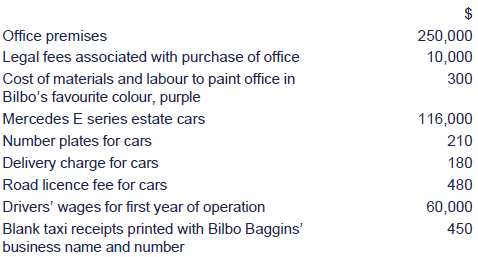
What amounts should be capitalised as 'Land and buildings' and 'Motor vehicles'?


5 Depreciation
- IAS 16 defines depreciation as 'the measure of the cost or revalued amount of the economic benefits of the tangible non-current asset that has been consumed during the period'.
- In simple terms, depreciation is a mechanism to reflect the cost of using a non-current asset.
- Depreciation matches the cost of using a non-current asset to the revenues generated by that asset over its useful life.
- Depreciation must also be matched to the pattern of use of the asset. This must be regularly reviewed and may be changed if the method no longer matches the usage of the asset.
- This is achieved by recording a depreciation charge each year, the effect of which is twofold ('the dual effect'):
- Reduce the statement of financial position value of the non-current asset by cumulative depreciation to reflect the wearing out.
- Record the depreciation charge as an expense in the income statement to match to the revenue generated by the non-current asset.

 Depreciation
Depreciation
Depreciation may arise from:
- use
- physical wear and tear
- passing of time, e.g. a ten-year lease on a property
- obsolescence through technology and market changes, e.g. plant and machinery of a specialised nature
- depletion, e.g. the extraction of a mineral from a quarry.
The purpose of depreciation is not to show the asset at its currentvalue in the statement of financial position, nor is it intended toprovide a fund for the replacement of the asset. It is simply a methodof allocating the cost of the asset over the periods estimated tobenefit from its use (the useful life).
Land normally has an unlimited life and so does not require depreciation, but buildings should be depreciated.
Depreciation of an asset begins when it is available for use.

6 Methods of calculating depreciation
Straight-line method
Depreciation charge = (Cost – Residual value)/Useful life
Or X% x cost
 Residual value: the estimated disposal value of the asset at the end of its useful life.
Residual value: the estimated disposal value of the asset at the end of its useful life.
 Useful life: the estimated number of years during which the business will use the asset.
Useful life: the estimated number of years during which the business will use the asset.

 Residual value
Residual value
The residual value may be a second-hand value or scrap value. It is unlikely to be a significant amount and is often zero.
The useful life does not necessarily equal the physical life of theasset. For example many businesses use a three-year useful life forcomputers. This does not mean that a computer can no longer be usedafter three years; it means that the business is likely to replace thecomputer after three years due to technological advancement.
Straight-line depreciation is often expressed as a percentage oforiginal cost, so that straight-line depreciation over four years wouldalternatively be described as straight-line depreciation at 25% pa.

Reducing balance method
Depreciation charge = X % x carrying value (CV)
 CV: original cost of the non-current asset less accumulated depreciation on the asset to date.
CV: original cost of the non-current asset less accumulated depreciation on the asset to date.
Assets bought/sold in the period
If a non-current asset is bought or sold in the period, there are two ways in which the depreciation could be accounted for:
- provide a full year's depreciation in the year of acquisition and none in the year of disposal
- monthly or pro-rata depreciation, based on the exact number of months that the asset has been owned.

 Illustration 1 – Reducing balance method
Illustration 1 – Reducing balance method
Dev, a trader, purchased an item of plant for $1,000 on 1 August20X1 which he depreciates on the reducing balance at 20% pa. What is thedepreciation charge for each of the first five years if the accountingyear end is 31 July?


 Solution
Solution
Solution



 Test your understanding 2
Test your understanding 2
Karen has been running a successful nursery school 'LittleMonkeys' since 20X1. She bought the following assets as the nurserygrew:
- a new oven for the nursery kitchen at a cost of $2,000 (purchased 1 December 20X4).
- a minibus to take the children on trips for $18,000 (purchased 1 June 20X4).
She depreciates the oven at 10% straight line and the minibus at25% reducing balance. A full year's depreciation is charged in the yearof purchase and none in the year of disposal.
What is the total depreciation charge for the year ended 31 October 20X6?
A $2,531
B $2,700
C $4,231
D $2,731


 Test your understanding 3
Test your understanding 3
The following information relates to Bangers & Smash, a car repair business:

What is the total depreciation charge for the years ended 31 December 20X5 and 20X6?
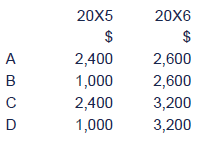

7 Accounting for depreciation
Whichever method is used to calculate depreciation, the accounting remains the same:
Dr Depreciation expense (IS) X
Cr Accumulated depreciation (SFP) X
- The depreciation expense account is an income statement account and therefore is not cumulative.
- The accumulated depreciation account is a statement of financial position account and as the name suggests is cumulative, i.e. reflects all depreciation to date.
- On the statement of financial position it is shown as a reduction against the cost of non-current assets:


 Illustration 2 – Accounting for depreciation
Illustration 2 – Accounting for depreciation
Santa runs a large toy shop in Windsor. In the year ended 31 August 20X5, she bought the following fixed assets:
- A new cash register for $5,000. This was purchased on 1 December 20X4, in time for the Christmas rush, and was to be depreciated at 10% straight line.
- A new delivery van, purchased on 31 March 20X5, at a cost of $22,000. The van is to be depreciated at 15% reducing balance.
Santa charges depreciation on a monthly basis.
- What is the depreciation charge for the year ended 31st August 20X5?
- Show the relevant ledger accounts and statement of financial position presentation at that date.


 Solution
Solution
Solution
Cash register Depreciation charge: 10% x $5,000 x 9/12
= $375
Delivery van Depreciation charge: 15% x $22,000 x 5/12
= $1,375
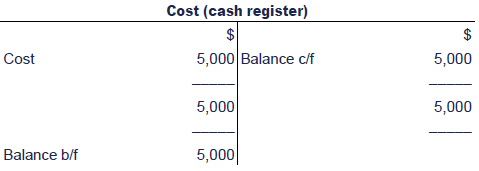


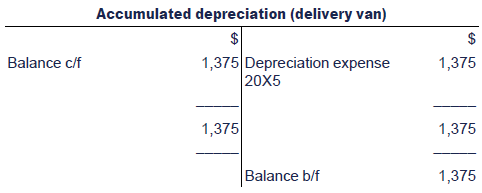
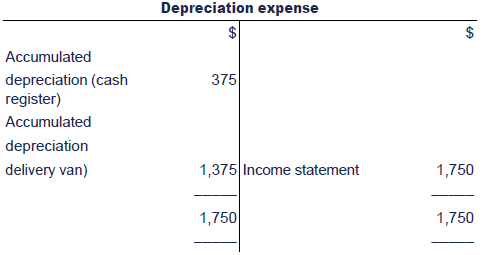
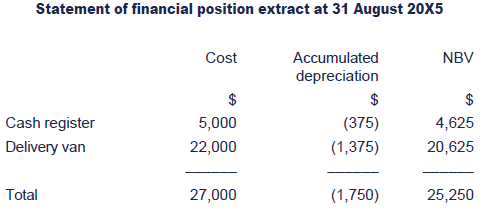


 Test your understanding 4
Test your understanding 4
Coco acquired two fixed assets for cash on 1 August 20X5 for use in her party organising business:
- a 25-year lease on a shop for $200,000
- a chocolate fountain for $4,000.
The fountain is to be depreciated at 25% pa using the reducing balance method.
A full year of depreciation is charged in the year of acquisition and none in the year of disposal.
Show the ledger account entries for these assets for the years ending 31 October 20X5, 20X6 and 20X7.

8 Consistency and subjectivity when accounting for depreciation
The following are all based on estimates made by the management of a business:
- depreciation method
- residual value
- useful life.
Different estimates would result in varying levels of depreciation and, consequently, profits.
It can be argued that these subjective areas could therefore result in manipulation of the accounts by management.
In order to reduce the scope for such manipulation and increase consistency of treatment, IAS 16 Property, Plant and Equipment requires the following:
- Depreciation method should be reviewed at each year end and changed if the method used no longer reflects the pattern of use of the asset.
- Residual value and useful life should be reviewed at each year end and changed if expectations differ from previous estimates.

 Illustration 3 – Changes to estimates
Illustration 3 – Changes to estimates
Alfie purchased a non-current asset for $100,000 on 1 January20X2 and started depreciating it over five years. Residual value wastaken as $10,000.
At 1 January 20X3 a review of asset lives was undertaken and theremaining useful life was estimated at eight years. Residual value wasestimated as nil.
Calculate the depreciation charge for the year ended 31 December 20X3 and subsequent years.


 Solution to changes in estimates
Solution to changes in estimates
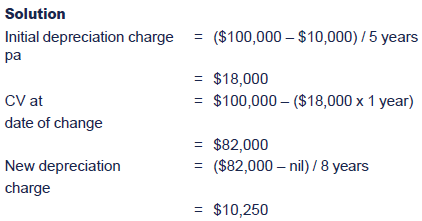


 Test your understanding 5
Test your understanding 5
Alberto bought a wood-burning oven for his pizza restaurant for$30,000 on 1 January 20X0. At that time he believed that the oven'suseful life would be 20 years after which it would have no value.
On 1 January 20X3, Alberto revises his estimations: he now believesthat he will use the oven in the business for another 12 years afterwhich he will be able to sell it second-hand for $1,500.
What is the depreciation charge for the year ended 31 December 20X3?
A $2,000
B $2,125
C $1,875
D $2,375

9 Disposal of non-current assets
Profit/loss on disposal

Note: A disposals T account is required when recording thedisposal of a non-current asset. This is an income statement accountwhich reflects any profit or loss on disposal.
Disposal for cash consideration
This is a three-step process:
(1) Remove the original cost of the non-current asset from the 'non-current asset' account.
Dr Disposals original cost
Cr NC assets original cost
(2) Remove accumulated depreciation on the non-current asset from the 'accumulated depreciation' account.
Dr Acc'd dep'n acc'd dep'n
Cr Disposals acc'd dep'n
(3) Record the cash proceeds.
Dr Cash proceeds
Cr Disposals proceeds
The balance on the disposals T account is the profit or loss on disposal:

The profit or loss on disposal can also be calculated as proceeds less NBV of asset at disposal.

 Test your understanding 6
Test your understanding 6
Percy Throwerp runs a landscape gardening business. On 1 February20X2, he purchased a sit-on lawnmower costing $3,000. He depreciates itat 10% straight line on a monthly basis. A few years later he decidesto replace it with one which has an enclosed cabin for when it rains. Hesells the lawnmower to an old friend, Alan Titchmuck, for $2,000 on 31July 20X5.
How much is charged to Percy's income statement in respect of the asset for the year ended 31 December 20X5?

Disposal through a part exchange agreement (PEA)
A part exchange agreement arises where an old asset is providedin part payment for a new one, the balance of the new asset being paidin cash.
The procedure to record the transaction is very similar to thethree-step process seen for a cash disposal. The first two steps areidentical, however steps 3 and 4 are as follows:
(3) Record the part exchange allowance (PEA) as proceeds.
Dr NC assets (= part of cost of new asset) PEA
Cr Disposals (= sale proceeds of old asset) PEA
(4) Record the cash paid for the new asset.
Dr NC assets cash
Cr Cash cash
Again, the balance on the disposals T account is the profit or loss on disposal:
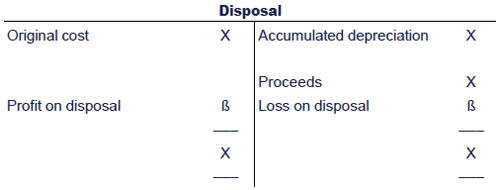

 Disposals
Disposals
There are two debits to the non-current asset account in respect of the new asset:
Together these are the cost of the new asset. If preferred you canshow the total as one debit (however do not forget to record bothcredits).


 Test your understanding 7
Test your understanding 7
Bindi Bobbin runs a business altering and repairing clothes. Whenshe started business on 1 January 20X2, she bought a Soopastitch IIsewing machine for $2,500. She depreciates sewing machines using thestraight-line method at a rate of 20% pa, and she charges a full year ofdepreciation in the year of acquisition and none in the year ofdisposal.
The business has now grown such that she needs a faster machine,and she will upgrade to the Soopastitch V during December 20X5. TheSoopastitch salesman has offered her a part exchange deal as follows:
Part exchange allowance for Soopastitch II $750
Balance to be paid in cash for Soopastitch V $4,850
Show the ledger entries for the year ended 31 December 20X5 to reflect this transaction.

10 Revaluation of non-current assets
- Some non-current assets, such as land and buildings may rise in value over time. Businesses may choose to reflect the current value of the asset in their statement of financial position. This is known as revaluing the asset.
- The difference between the CV of the asset and the revalued amount (normally a gain) is recorded in a revaluation reserve in the capital section of the statement of financial position.
- This gain is not recorded in the income statement because it is unrealised, i.e. it is not realised in the form of cash.
- IAS 1 requires that a revaluation gain is disclosed in "other comprehensive income" on the statement of comprehensive income. (this is later covered within chapter 15)

 Fair values
Fair values
If the fair value of a non-current asset can be measuredreliably, it can be carried at its fair value at the date ofrevaluation, less any subsequent depreciation and impairment losses. Therevaluation should be repeated regularly to ensure that the fair valueof the asset does not differ materially from the carrying amount.
An upward revaluation should be credited to revaluation surplus,unless it reverses a previous downward revaluation which was charged asan expense.
A downward revaluation should be charged as an expense, unless itreverses a previous upward revaluation, when it may be charged againstthe revaluation surplus for that same asset.
If one asset in a class is revalued, all assets of that class mustbe revalued. This is to prevent selective revaluation of only thoseassets that have increased in value.


 Illustration 4 – Revaluation of non-current assets
Illustration 4 – Revaluation of non-current assets
Vittorio owns land which originally cost $250,000. Nodepreciation has been charged on the land in accordance with IAS 16.Vittorio wishes to revalue the land to reflect its current market value,which he has been advised is $600,000.
What is the double entry to record this revaluation?


 Land revaluation
Land revaluation
Solution
The land is currently held at cost of $250,000. This needs to beincreased by $350,000 to reflect the new valuation of $600,000.Therefore the double entry required is:
Dr Land cost $350,000
Cr Revaluation reserve $350,000


 Illustration 5 – Revaluation of non-current assets
Illustration 5 – Revaluation of non-current assets
Hamish runs a kilt-making business in Scotland. He has run thebusiness for many years from a building which originally cost $300,000and on which $100,000 total depreciation has been charged to date.Hamish wishes to revalue the building to $750,000.
What is the double entry required to record the revaluation?


 Solution to revaluation of NCA's
Solution to revaluation of NCA's
Solution
The current balances in the accounts are:
Building cost $300,000
Accumulated depreciation $100,000
- The building cost account needs to be raised by $450,000 to $750,000.
- On revaluation, the accumulated depreciation account is cleared out.
Therefore the double entry required is:
Dr Building cost $450,000
Dr Accumulated depreciation $100,000
Cr Revaluation reserve $550,000
The gain of $550,000 reflects the difference between the NBV pre-revaluation of $200,000 and the revalued amount of $750,000.
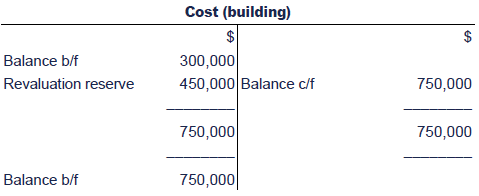

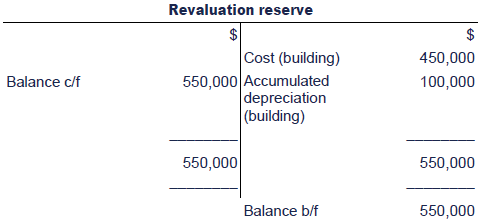
Extract from the Statement of comprehensive income: (covered in more detail within chapter 17)
Other comprehensive income:
Gain on property revaluation $450,000

In summary:
Revaluation surplus = Revalued amount – NBV
For a non-depreciated asset:
For a depreciated asset:
The revaluation gain is disclosed on the face of the statement ofcomprehensive income under "other comprehensive income" and in thestatement of changes in equity (SOCIE).

 Test your understanding 8
Test your understanding 8
Max owns a fish-finger factory. The premises were purchased on 1January 20X1 for $450,000 and depreciation charged at 2% pa straightline.
Max now wishes to revalue the factory premises to $800,000 on 1 January 20X7 to reflect the market value.
What is the balance on the revaluation reserve after this transaction?
A $350,000
B $395,000
C $404,000
D $413,000

11 Depreciation and disposal of a revalued asset
Depreciation of a revalued asset
- When a non-current asset has been revalued, the charge for depreciation should be based on the revalued amount and the remaining useful life of the asset.
- this charge will be higher than depreciation prior to the revaluation.
- the excess of the new depreciation charge over the old depreciation charge should be transferred from the revaluation reserve to accumulated profits (within the capital section of the statement of financial position):
Dr Revaluation reserve X
Cr Accumulated profits X

 Illustration 6 – Depreciation of a revalued asset
Illustration 6 – Depreciation of a revalued asset
Eddie owns a retail unit in central Springfield. He bought it 25years ago for $100,000, depreciating it over 50 years. At the start of20X6 he decides to revalue the unit to $800,000. The unit has aremaining useful life of 25 years.
What accounting entries should be made in 20X6?


 Solution
Solution
Solution
On revaluation at start of 20X6
Dr Retail unit cost $700,000
Dr Accumulated depreciation $50,000
Cr Revaluation reserve $750,000
Depreciation for 20X6
Dr Depreciation expense($800,000/25 yrs) $32,000
Cr Accumulated depreciation $32,000
Reserves transfer for 20X6
Dr Revaluation reserve ($32,000 – $2,000) $30,000
Cr Accumulated profits $30,000


 Test your understanding 9
Test your understanding 9
Spartacus United football club's statement of financial position at 31 December 20X7 includes the following information:

Depreciation has been provided at 2% on the straight-line basis.
The stadium is revalued on 30 June 20X8 to $1,380,000. There is no change in its remaining estimated future useful life.
What is the depreciation charge for the year ended 31 December 20X8?


 Test your understanding 10
Test your understanding 10
Tiger Trees owns and runs a golf club. Some years ago Tigerpurchased land next to the existing course with the intention ofcreating a smaller nine-hole course. The cost of the land was $260,000.Tiger hasn't yet built the additional course but has revalued this landto $600,000. He has now decided that building the new course isuneconomical and has found a buyer who is willing to pay $695,000 forthe land.
What are the ledger entries on disposal?

Disposal of a revalued asset
- The disposal of a revalued asset is recorded as already seen.
12 Disclosure of non-current asset balances in company financial statements

 IAS 16 PPE Disclosure
IAS 16 PPE Disclosure
IAS 16 Property Plant and Equipment contains a number ofdisclosure requirements relating to non-current assets. Here are themain ones:
(1) The measurement bases used forarriving at the carrying amount of the asset (e.g. cost or valuation).If more than one basis has been used, the amounts for each basis must bedisclosed.
(2) Depreciation methods used, with details of useful lives or the depreciation rates used.
(3) The gross amount of each assetheading and its related accumulated depreciation (aggregated withaccumulated impairment losses) at the beginning and end of the period.
(4) A reconciliation of the carrying amount at the beginning and end of the period, showing:
- additions
- assets classified as held for sale
- disposals
- revaluations
- depreciation.
(5) Any commitments for future acquisition of property, plant and equipment.
(6) If assets are stated at revalued amounts, the following should be disclosed:
- the effective date of the revaluation
- whether an independent valuer was involved
- the methods and assumptions applied in estimating the items' fair value
- the carrying amount that would have been recognised had the assets been carried at cost
- the revaluation surplus, indicating the change for the period.


 IAS 38 Intangible assets treatment
IAS 38 Intangible assets treatment
Intangible assets
Many businesses invest significant amounts with the intention of obtaining future value on areas such as:
- scientific/technical knowledge
- design of new processes and systems
- licences and quotas
- intellectual property, e.g. patents and copyrights
- market knowledge, e.g. customer lists, relationships and loyalty
- trademarks
All these expenses may result in future benefits to the business, but not all can be recognised as assets.
Objective of IAS 38 Intangible assets
The objective of IAS 38 is to prescribe the specific criteriathat must be met before an intangible asset can be recognised in theaccounts.
Definition
An intangible asset is an identifiable non-monetary asset without physical substance.
To meet the definition the asset must be identifiable, i.e.separable from the rest of the business or arising from legal rights.
It must also meet the normal definition of an asset:
- controlled by the entity as a result of past events (normally by enforceable legal rights)
- a resource from which future economic benefits are expected to flow (either from revenue or cost saving)
Recognition
To be recognised in the financial statements, an intangible asset must:
- meet the definition of an intangible asset, and
- meet the recognition criteria of the framework:
- it is probable that future economic benefits attributable to the asset will flow to the entity
- the cost of the asset can be measured reliably.
If these criteria are met, the asset should be initially recognised at cost.
Disclosure
The notes to the accounts will detail the total intangiblenon-current assets in the statement of financial position at net bookvalue.
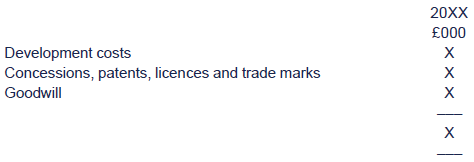

Chapter summary
Test your understanding answers

 Test your understanding 1
Test your understanding 1
The correct answer is A
Land and buildings
Office premises: $250,000
Legal fees: $10,000
Total: $260,000
- The cost of the purple paint does not form part of the cost of the office and so should not be capitalised. Instead it should be taken to the income statement as a revenue expense.
Motor vehicles
3 Mercedes E series $116,000
Number plates $210
Delivery charges $180
Total $116,390
- The number plates are one-off charges which form part of the purchase price of any car.
- The road licence fee, drivers' wages and receipts are ongoing expenses, incurred every year. They cannot be capitalised, but should be taken to the income statement as expenses.


 Test your understanding 2
Test your understanding 2
The correct answer is D
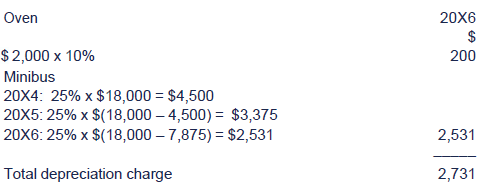


 Test your understanding 3
Test your understanding 3
The correct answer is B
Machine 1 $ $
20X5: 20% x $12,000 x 5/12 = 1,000
20X6: 20% x $12,000 = 2,400
Machine 2
20X6: 10% x $8,000 x 3/12 = 200
Total depreciation charge
20X5: 1,000
20X6: $2,400 + $200 2,600


 Test your understanding 4
Test your understanding 4

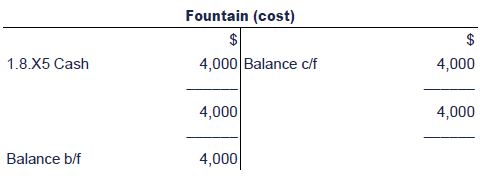
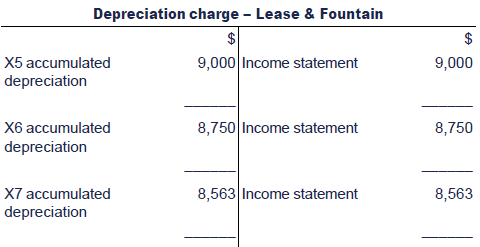

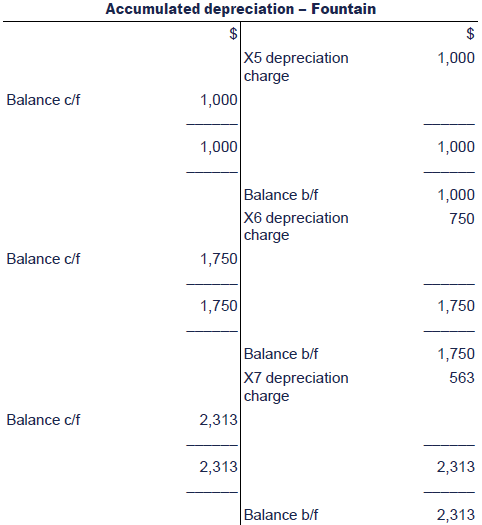
Annual depreciation workings:
Note, details of the depreciation method and rate for the lease arenot given in the question. We are however told that the lease term is25 years. This suggests that it would be appropriate to use thestraight-line method with a useful life of 25 years.
20X5
Lease: $200,000/25 years = 8,000
Fountain: $4,000 x 25% = 1,000
Total: 9,000
20X6
Lease: $200,000/25 years = 8,000
Fountain: $3,000 x 25% = 750
Total: 8,750
20X7
Lease: $200,000/25 years = 8,000
Fountain: $2,250 x 25% = 563
Total: 8,563


 Test your understanding 5
Test your understanding 5
The correct answer is A
Initial depreciation charge = $30,000 /20 years = $1,500
CV at date of change = $30,000 – ($1,500 x 3yrs)
New depreciation charge = $25,500 – $1,500 / 12 years


 Test your understanding 6
Test your understanding 6
(1) Dr Disposals $3,000
Cr Fixtures and fittings cost $3,000
(2) Dr Accumulated depreciation $1,050
Cr Disposals $1,050
Depreciation working:
X2 10% x 3,000 x 11/12 = 275
X3 10% x 3,000 = 300
X4 10% x 3,000 = 300
X5 10% x 3,000 x 7/12 = 175
Total: 1050
(3) Dr Cash $2,000
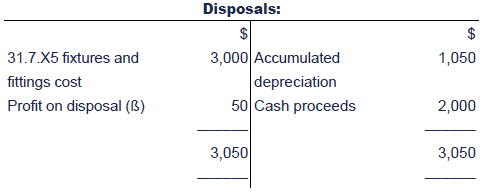
The charge to the income statement for the year ended 31 December 20X5 is: $
Depreciation charge for the year 175
Profit/loss on disposal (50)
Note: As depreciation is charged monthly, it is necessary to chargean amount to the income statement for the period 1 January 20X5 to thedisposal date 31 July 20X5.


 Test your understanding 7
Test your understanding 7


Depreciation b/f working:
$2,500 x 20% x 3 years = $1,500
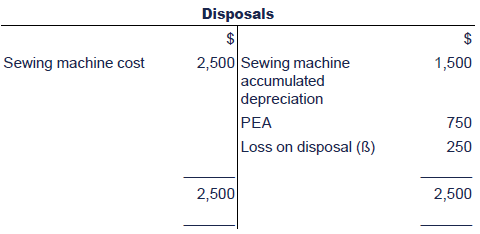

Depreciation charge working:
$5,600 x 20% = $1,120


 Test your understanding 8
Test your understanding 8
The correct answer is C


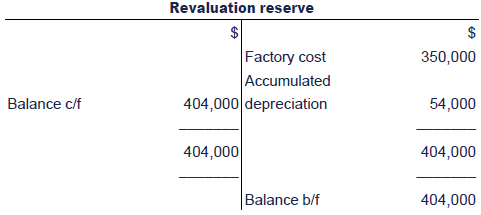


 Test your understanding 9
Test your understanding 9
Depreciation must continue to be charged on the original costuntil the date of revaluation. Thereafter it is charged on the revaluedamount:
1 January to 30 June 20X8
2% x $1,500,000 x 6/12
15,000
Note that this is part of the depreciation cleared out onrevaluation and so is not part of the accumulated depreciation balanceat the year end.
1 July to 31 December 20X8
(1,380,000/34.5 years)x (6/12)
20,000
This amount will form the accumulated depreciation at the year end.
Total depreciation charge


 Test your understanding 10
Test your understanding 10



|
Created at 5/24/2012 3:33 PM by System Account
(GMT) Greenwich Mean Time : Dublin, Edinburgh, Lisbon, London
|
Last modified at 5/25/2012 12:53 PM by System Account
(GMT) Greenwich Mean Time : Dublin, Edinburgh, Lisbon, London
|
|
|
|
 |
Rating
:
|
 Ratings & Comments
(Click the stars to rate the page) Ratings & Comments
(Click the stars to rate the page)
|
 |
Tags:
|
|
|
|
|